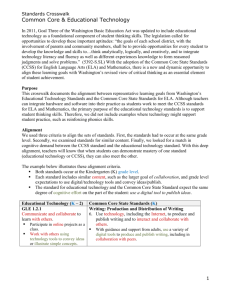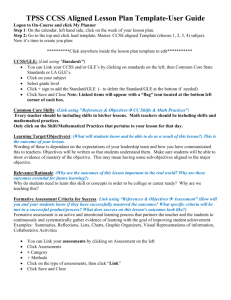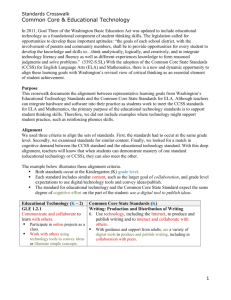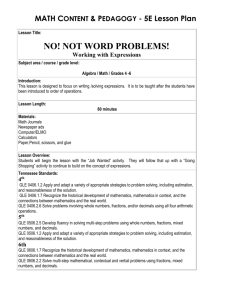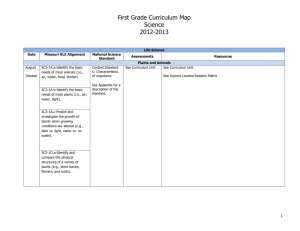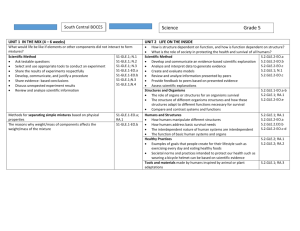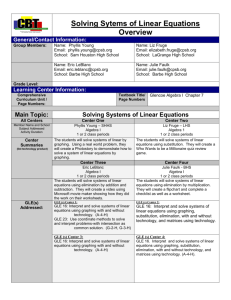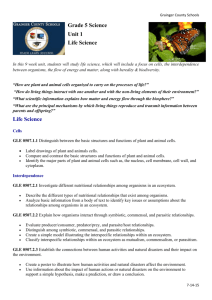Common Core Standards Crosswalk to Missouri GLEs/CLEs for
advertisement
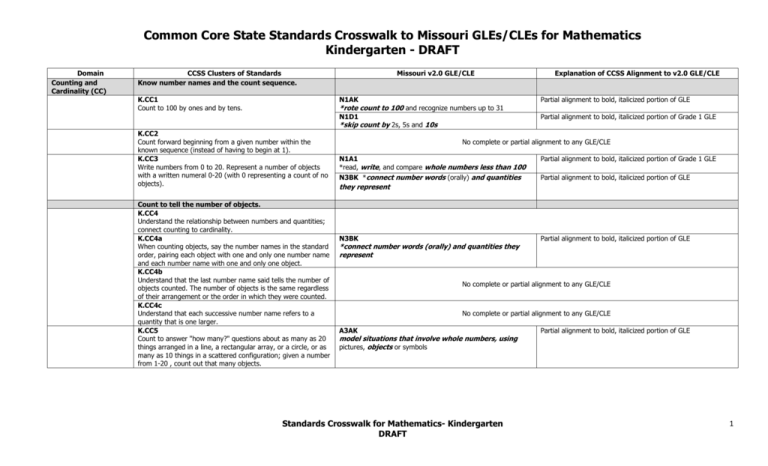
Common Core State Standards Crosswalk to Missouri GLEs/CLEs for Mathematics Kindergarten - DRAFT Domain Counting and Cardinality (CC) CCSS Clusters of Standards Know number names and the count sequence. K.CC1 Count to 100 by ones and by tens. Missouri v2.0 GLE/CLE N1AK Partial alignment to bold, italicized portion of GLE N1D1 Partial alignment to bold, italicized portion of Grade 1 GLE *rote count to 100 and recognize numbers up to 31 *skip count by 2s, 5s and 10s K.CC2 Count forward beginning from a given number within the known sequence (instead of having to begin at 1). K.CC3 Write numbers from 0 to 20. Represent a number of objects with a written numeral 0-20 (with 0 representing a count of no objects). Count to tell the number of objects. K.CC4 Understand the relationship between numbers and quantities; connect counting to cardinality. K.CC4a When counting objects, say the number names in the standard order, pairing each object with one and only one number name and each number name with one and only one object. K.CC4b Understand that the last number name said tells the number of objects counted. The number of objects is the same regardless of their arrangement or the order in which they were counted. K.CC4c Understand that each successive number name refers to a quantity that is one larger. K.CC5 Count to answer "how many?" questions about as many as 20 things arranged in a line, a rectangular array, or a circle, or as many as 10 things in a scattered configuration; given a number from 1-20 , count out that many objects. Explanation of CCSS Alignment to v2.0 GLE/CLE No complete or partial alignment to any GLE/CLE N1A1 *read, write, and compare whole numbers less than 100 Partial alignment to bold, italicized portion of Grade 1 GLE N3BK *connect number words (orally) and quantities Partial alignment to bold, italicized portion of GLE they represent N3BK *connect number words (orally) and quantities they represent Partial alignment to bold, italicized portion of GLE No complete or partial alignment to any GLE/CLE No complete or partial alignment to any GLE/CLE A3AK model situations that involve whole numbers, using pictures, objects or symbols Standards Crosswalk for Mathematics- Kindergarten DRAFT Partial alignment to bold, italicized portion of GLE 1 Common Core State Standards Crosswalk to Missouri GLEs/CLEs for Mathematics Kindergarten - DRAFT Domain Counting and Cardinality (CC) CCSS Cluster of Standards Compare Numbers. Missouri v2.0 GLE/CLE K.CC6 Identify whether the number of objects in one group is greater than, less than, or equal to the number of objects in another group, e.g., by using matching and counting strategies.1 [1Include groups with up to ten objects.] K.CC7 Compare two numbers between 1 and 10 presented as written numerals. Explanation of CCSS Alignment to v2.0 GLE/CLE N1A1 *read, write, and compare whole numbers less than 100 Partial alignment to bold, italicized portion of Grade 1 GLE N1A1 *read, write and compare whole numbers less than 100 Partial alignment to bold, italicized portion of Grade 1 GLE Standards Crosswalk for Mathematics- Kindergarten DRAFT 2 Common Core State Standards Crosswalk to Missouri GLEs/CLEs for Mathematics Kindergarten - DRAFT Domain Operations and Algebraic Thinking (OA) CCSS Cluster of Standards Understand addition as putting together and adding to, and understand subtraction as taking apart and taking from. K.OA1 Represent addition and subtraction with objects, fingers, mental images, drawings2, sounds (e.g., claps), acting out situations, verbal explanations, expressions, or equations. [2Drawings need not show details, but should show the mathematics in the problem.] K.OA2 Solve addition and subtraction word problems, and add and subtract within 10, e.g. by using objects or drawings to represent the problem. K.OA3 Decompose numbers less than or equal to 10 into pairs in more than one way, e.g., by using objects or drawings, and record each decomposition by a drawing or equation (e.g., 5 =2 + 3 and 5 = 4 + 1) Missouri v2.0 GLE/CLE N1CK Partial alignment to bold, italicized portion of GLE N2A1 Partial alignment to bold, italicized portion of Grade 1 GLE N2A1 Partial alignment to bold, italicized portion of Grade 1 GLE N1CK Partial alignment to bold, italicized portion of GLE N2A1 Partial alignment to bold, italicized portion of Grade 1 GLE A3AK Partial alignment to bold, italicized portion of GLE A3AK Partial alignment to bold, italicized portion of GLE *use concrete objects to compose and decompose values up to 10 *represent/model a given situation involving addition and subtraction of whole numbers using pictures, objects, or symbols *represent/model a given situation involving addition and subtraction of whole numbers using pictures, objects, or symbols *use concrete objects to compose and decompose values up to 10 *represent/model a given situation involving addition and subtraction of whole numbers using pictures, objects, or symbols model situations that involve whole numbers, using pictures, objects or symbols K.OA4 For any number from 1 to 9, find the number that makes 10 when added to the given number, e.g., by using objects or drawings, and record the answer with a drawing or equation. K.OA5 Fluently add and subtract within 5. Explanation of CCSS Alignment to v2.0 GLE/CLE model situations that involve whole numbers, using pictures, objects or symbols No complete or partial alignment to any GLE/CLE Standards Crosswalk for Mathematics- Kindergarten DRAFT 3 Common Core State Standards Crosswalk to Missouri GLEs/CLEs for Mathematics Kindergarten - DRAFT Domain Number and Operations in Base Ten (NBT) CCSS Cluster of Standards Work with numbers 11-19 to gain foundations for place value. K.NBT1 Compose and decompose numbers from 11 to 19 into tens and ones and some further ones, e.g., by using objects or drawings, and record each composition or decomposition by a drawing or equation (e.g., 18=10+8); understand that these numbers are composed of ten ones and one, two, three, four, five, six, seven, eight, or nine ones. Missouri v2.0 GLE/CLE Explanation of CCSS Alignment to v2.0 GLE/CLE N1C1 Partial alignment to bold, italicized portion of Grade 1 GLE multiple strategies such as known facts, doubles and close to doubles, tens, and one place value A3AK model situations that involve whole numbers, Partial alignment to bold, italicized portion of GLE *compose or decompose whole numbers up to 20 using using pictures, objects or symbols Standards Crosswalk for Mathematics- Kindergarten DRAFT 4 Common Core State Standards Crosswalk to Missouri GLEs/CLEs for Mathematics Kindergarten - DRAFT Domain Measurement and Data (MD) CCSS Cluster of Standards Describe and compare measurable attributes. K.MD1 Describe measurable attributes of objects, such as length or weight. Describe several measurable attributes of a single object. K.MD2 Directly compare two objects with a measurable attribute in common, to see which object has "more of"/"less of" the attribute, and describe the difference. For example, directly compare the heights of two children and describe one child as taller/shorter. Classify objects and count the number of objects in each category. K.MD3 Classify objects into given categories; count the numbers of objects in each category and sort the categories by count.3 [3Limit category counts to be less than or equal to 10] Missouri v2.0 GLE/CLE Explanation of CCSS Alignment to v2.0 GLE/CLE No complete or partial alignment to any GLE/CLE M1AK Partial alignment to bold italicized portion of GLE M2AK Partial alignment to bold, italicized portion of GLE D1BK Partial alignment to bold, italicized portion of GLE D1B1 Partial alignment to bold, italicized portion of Grade 1 GLE *compare and order objects according to their size or weight *measure objects by comparison of lengths (shorter, same, longer) *sort items according to their attributes *sort and classify items according to their attributes Standards Crosswalk for Mathematics- Kindergarten DRAFT 5 Common Core State Standards Crosswalk to Missouri GLEs/CLEs for Mathematics Kindergarten - DRAFT Domain Geometry (G) CCSS Cluster of Standards Identify and describe shapes (squares, circles, triangles, rectangles, hexagons, cubes, cones, cylinders, and spheres). K.G1 Describe objects In the environment using names of shapes, and describe the relative positions of these objects using terms such as above, below, beside, in front of, behind, and next to. Missouri v2.0 GLE/CLE G1AK *identify and describe 2- and 3- dimensional shapes using physical models (circle, rhombus, rectangle, triangle, sphere, rectangular prism, cylinder, pyramid) that Partial alignment to bold, italicized portion of GLE G2AK Partial alignment to bold, italicized portion of GLE G1AK Partial alignment to bold, italicized portion of GLE represent shapes in their environment *describe, name and interpret relative positions in space (above, below, front, behind) K.G2 Correctly name shapes regardless of their orientations or overall size. K.G3 Identify shapes as two-dimensional (lying in a plane, "flat") or three-dimensional ("solid"). Analyze, compare, create, and compose shapes. K.G4 Analyze and compare two- and three-dimensional shapes, in different sizes and orientations, using informal language to describe their similarities, differences, parts (e.g., having sides of equal length.) K.G5 Model shapes in the world by building shapes from components (e.g., sticks and clay balls) and drawing shapes K.G6 Compose simple shapes to form larger shapes. For example, "Can you join these two triangles with full sides touching to make a rectangle?" Explanation of CCSS Alignment to v2.0 GLE/CLE *identify and describe 2- and 3- dimensional shapes using physical models (circle, rhombus, rectangle, triangle, sphere, rectangular prism, cylinder, pyramid) that represent shapes in their environment G1AK *identify and describe 2- and 3- dimensional shapes using physical models (circle, rhombus, rectangle, triangle, sphere, rectangular prism, cylinder, pyramid) that represent shapes in their environment G1A3 *compare and analyze 2- dimensional shapes by Partial alignment to bold, italicized portion of GLE Partial alignment to bold, italicized portion of Grade 3 GLE describing their attributes (circle, rectangle, rhombus, trapezoid, triangle) No complete or partial alignment to any GLE/CLE G1C1 *use models to compose and decompose 2-dimensional shapes Standards Crosswalk for Mathematics- Kindergarten DRAFT Partial alignment to bold, italicized portion of Grade 1 GLE 6

